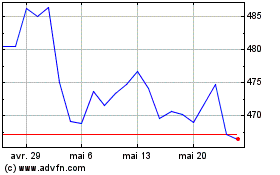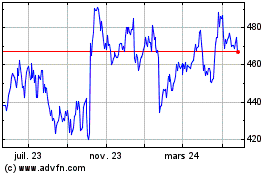Pentagon Awards Northrop Grumman Big Bomber Deal
28 Octobre 2015 - 12:00AM
Dow Jones News
The Pentagon awarded Northrop Grumman Corp. a huge contract to
build new long-range bombers for the U.S. Air Force after the
market close on Tuesday.
Northrop Grumman Corp. was vying with the team of Boeing Co. and
Lockheed Martin Corp. to build an initial 21 jets of the 100 sought
by the Air Force to replace aging B-52 and B-1 planes at an
estimated cost of $80 billion. The first aircraft are due to enter
service in the mid-2020s.
Shares of Northrop Grumman were up 6.3% in after-hours
trading.
The new radar-evading bomber is designed to fly undetected into
the territory of potential adversaries such as Russia or China that
have upgraded their air defenses. The plane is capable of firing
conventional and nuclear weapons, becoming the third leg of the
nuclear triad alongside submarine and land-based ballistic
missiles
The announcement follows what analysts have called the most
fiercely fought military-contract contests in more than a decade.
It concludes a four-year process clouded in secrecy as most of the
bomber's details were highly classified.
Defense Secretary Ash Carter is due to hold a media conference
after the contract announcement.
Pentagon officials have in recent weeks provided a few more
details on what the Air Force has called one of its top three
priorities, alongside the Lockheed-built F-35 fighter and
Boeing-built KC-46A refueling tanker.
Analysts said the additional disclosures reflected heightened
scrutiny from lawmakers because of the program's huge cost, as well
as the likelihood that the loser will protest the initial contract
award.
Defense experts had said Boeing or Northrop could be forced to
shrink or sell parts of their military aircraft business if they
lost.
However, the chief executives of Boeing and Northrop
Grumman—which reports third quarter earnings before the market open
on Wednesday—have both played down the notion of the bomber contest
being transformational to their businesses.
Plans for a new bomber were cancelled in 2009 before being
revived shortly afterward, with the proposed planes viewed as more
effective than long-range cruise missiles.
Other technologies such as hypersonic jets or swarms of unmanned
drones aren't considered to be mature enough, though critics of the
bomber plan have said it could become outdated as air-defense
technology improves, and didn't address the challenges created by
the emergence of new military threats such as Isis.
The bomber plan will be closely watched as the Pentagon and
lawmakers try to overhaul the way it designs and builds weapons
systems to break a run of cost over-runs and delays.
The Pentagon has capped the average production cost of each
bomber at $550 million in 2010 dollars, though this excludes what
analysts estimate to be around $20 billion in development
funding.
It's also tried to use existing technologies in an effort to
reduce costs and risks.
"Just because it's existing technology doesn't mean it's not
incredible," Air Force acquisition chief Bill LaPlante told
reporters last week.
Previous bomber programs have been severely curtailed because of
funding issues. Northrop built only 21 B-2s from an original plan
for 132, with a cost of more than $1 billion each.
The Pentagon isn't expected to disclose other suppliers involved
in the Northrop and Boeing/Lockheed bids, including who might
supply the engines and radars. However, General Electric Co. and
the Pratt & Whitney arm of United Technologies Corp. are
expected to have offered competing engines, according to industry
officials.
Write to Doug Cameron at doug.cameron@wsj.com
Subscribe to WSJ: http://online.wsj.com?mod=djnwires
(END) Dow Jones Newswires
October 27, 2015 18:45 ET (22:45 GMT)
Copyright (c) 2015 Dow Jones & Company, Inc.
Northrop Grumman (NYSE:NOC)
Graphique Historique de l'Action
De Juin 2024 à Juil 2024

Northrop Grumman (NYSE:NOC)
Graphique Historique de l'Action
De Juil 2023 à Juil 2024
